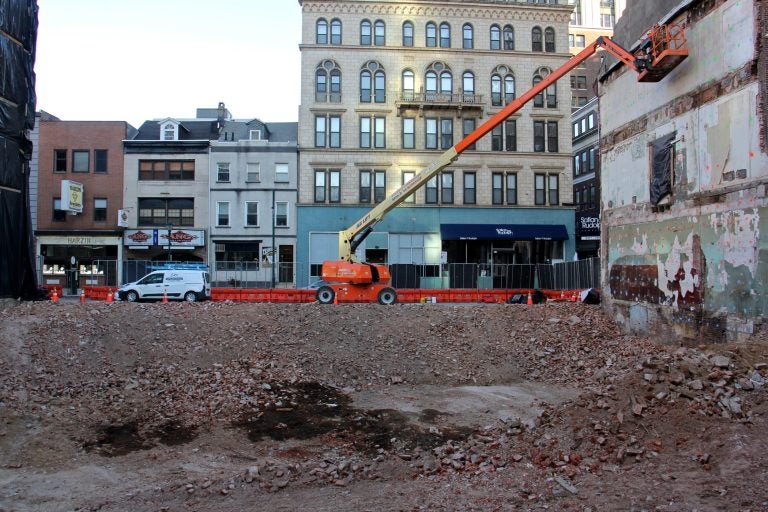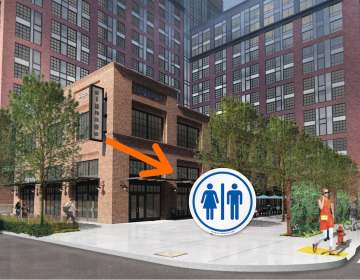Too late to save Philly’s historic Jewelers’ Row? Neighborhood property owners think so
A proposal to make Jewelers’ Row a historic district is reigniting a battle over the future of the changing Center City neighborhood.

The site at 702 Sansom Street, where Toll Brothers is building a condo tower, has taken a big chunk out of Jewelers Row. (Emma Lee/WHYY)
There’s a hole in Jewelers’ Row.
As historic preservationists long dreaded, a yawning gap scars the eastern end of Sansom Street where the urban-living wing of Toll Brothers, the luxury home-builder, plans a 24-story condo building.
Although it isn’t yet clear when construction will begin on the tower, a new battle is brewing on Jewelers’ Row. A proposed historic district, covering 57 properties on Sansom and adjoining parts of the surrounding blocks, will finally be reviewed by the Historical Commission in March after three years of delay.
Most property owners that would be covered by the new district are fiercely opposed to the idea, just as they supported the Toll Brothers project in the midst of their venerable commercial corridor.
“They were trying to stop the Toll Brothers, but that train has left,” said Paramjit Singh, who owns two properties on Sansom Street, the heart of the proposed historic district. “Just because they cannot take it on the chin, they are making other property owners suffer.”
Singh spoke before the city’s Planning Commission on Tuesday, denouncing the proposal as a misguided attempt to arrest the development of Jewelers’ Row just as its native industry is fading.
Michael Phillips, an attorney with the local firm Obermayer, joined Singh in dissent.
“What this nomination proposes to do is to freeze in time the rest of the block, and stop and prohibit any further development without Historic Commission approval,” said Phillips, who represents a few dozen property owners who control 33 of the 57 affected properties.
“Ironically, the history of this block is evolution. In the early 1800s it was a residential block, it then transitioned to Printers’ Row, then as the printing industry began declining in the 1930s it became known as Jewelers’ Row,” said Phillips. “But now we are entering into a new phase. Retail is struggling. The jewelry industry is struggling. Jewelers’ Row is going through its next evolution. This would stop that.”
But preservationists argue that they are only trying to stop the demolition of the historic fabric that defines Jewelers Row – and Philadelphia itself.
Historic protections do not determine a building’s use but rather its appearance, preservationists argue. The zoning code determines how a site can be used and Jewelers’ Row is governed by one of the city’s least-restrictive zoning codes, allowing any number of commercial and residential uses.
Many property owners have renovated their historic buildings and rent out the upper floors as apartments, notes Patrick Grossi of the Preservation Alliance, and historic preservation regulations wouldn’t impede such transitions.
But they would make it harder to raze a building and throw up, say, a shiny new condo tower in its place.
“A district designation does not freeze properties in time, because preservation is about managing change,” said Grossi, who is director of advocacy for the Alliance. “This district would not require Jewelers’ Row to be a jewelry commercial corridor for time immemorial.”

This new battle over Jewelers’ Row could still keep the Toll Brothers in the fight.
Even though the Jewelers’ Row Historic District has not yet been considered by the Historical Commission, it still wields jurisdiction over the properties covered by the proposed district.
That means, if the district moves forward, the Toll Brothers project that started all the neighborhood drama will still be subject to the commission’s consideration.
But city officials say that it is not yet clear what degree of oversight the body will have over the project. That’s because when the historic district proposal first came under consideration, the developer hadn’t yet demolished the old buildings. In historic districts, the commission wields much greater power over existing buildings. The city board can veto redevelopment proposals and require changes to their size, massing, scale, and materials to ensure a structure fits into the historic environment.
But their power over vacant land in a historic district is far less robust. If the recently cleared Toll Brothers-owned lot is considered an “undeveloped site,” then the Historical Commission will only be able to review the design. Any proposals they make will be purely advisory (much like those made by the city’s Civic Design Review board).
“It depends on the exact status of the properties that have been taken down and the nature of the specific applications that come in,” said Leonard Reuter, a senior attorney with the City of Philadelphia. “We’ll just have to wait and see if, and when, a building permit application comes in.”
A spokesperson for Toll Brothers said that they are unable to comment on the pending district.
Phillips and Singh accused the Preservation Alliance of initiating the Jewelers’ Row Historic District as a backdoor means of stopping the Toll Brothers project, or at least making life more difficult for their opponents while making collateral damage of the other property owners.
Grossi dismissed that notion.
“Our motivation for nominating Jewelers’ Row was not to stop the Toll Brothers project, it was to protect the entirety of Jewelers’ Row, or what was left of it,” he said.
WHYY is your source for fact-based, in-depth journalism and information. As a nonprofit organization, we rely on financial support from readers like you. Please give today.







